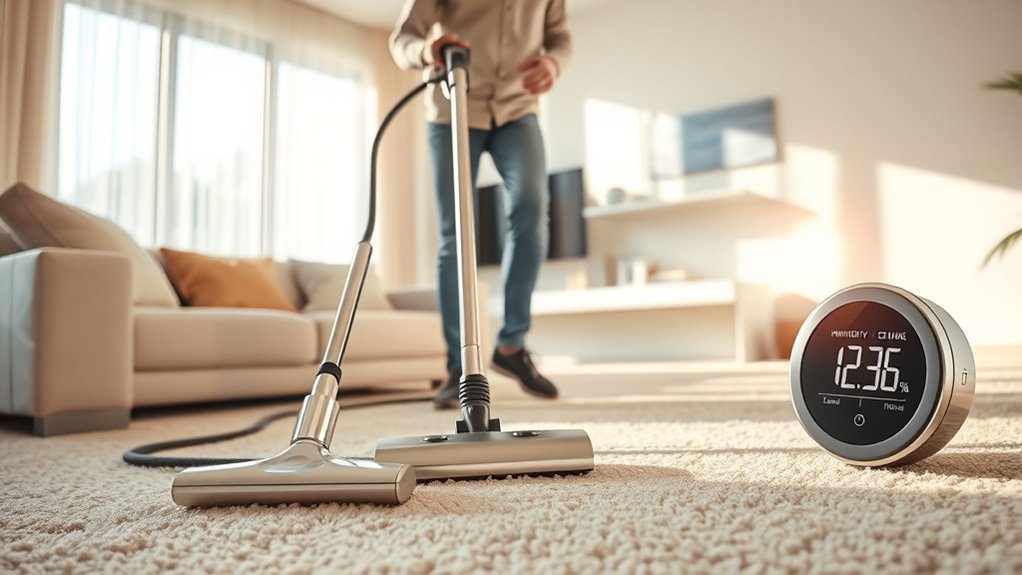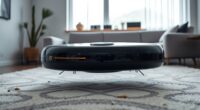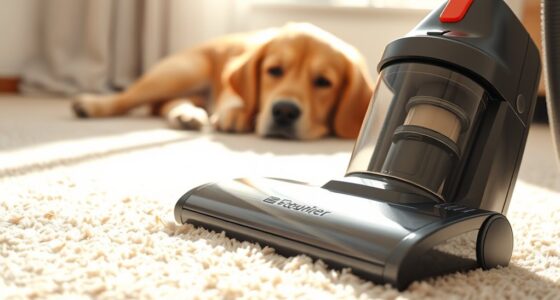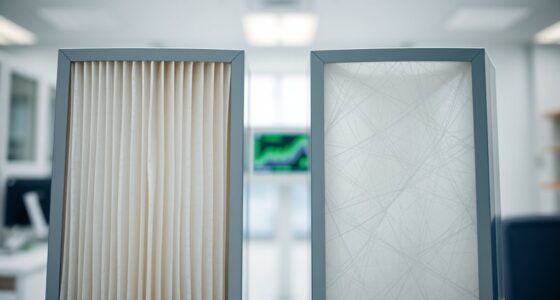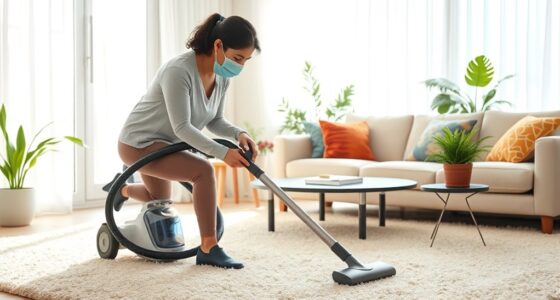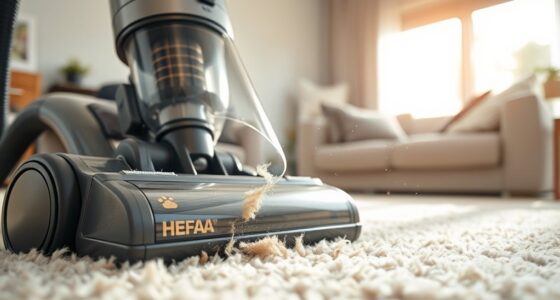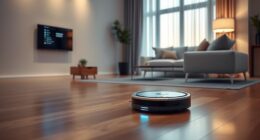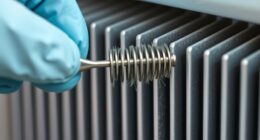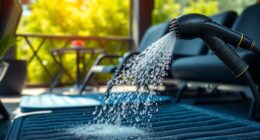Regular vacuuming helps manage indoor humidity by reducing dust, pet dander, and debris that trap moisture, preventing excess dampness and mold growth. When you keep your vacuum well-maintained and use filters like HEPA, you prevent allergens from circulating, which can influence how humid your space feels. Less dust and moisture retention mean a healthier, more comfortable environment. If you want to discover even more surprising ways vacuuming affects your indoor air and humidity, keep exploring.
Key Takeaways
- Regular vacuuming reduces airborne allergens, which can influence perceived indoor humidity levels indirectly.
- Well-maintained HEPA filters in vacuums efficiently trap moisture-retaining particles, improving air quality.
- Removing dust and debris decreases surface moisture retention, helping to control indoor humidity.
- Proper vacuum use prevents allergen release that could increase perceived dampness or stuffiness.
- Reducing settled allergens and debris minimizes mold growth risk, contributing to balanced indoor humidity.
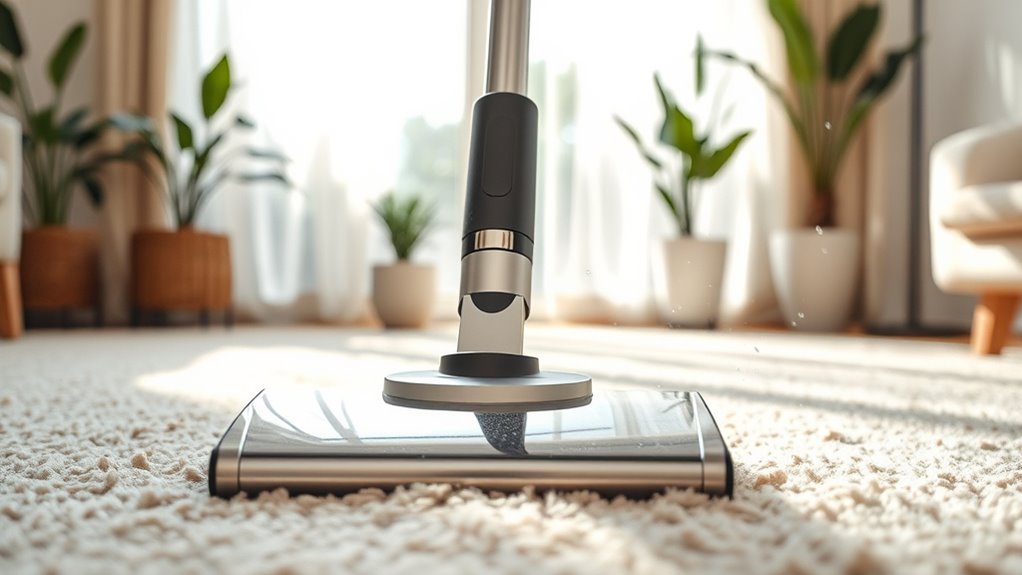
Have you ever wondered how vacuuming affects the humidity levels inside your home? It might seem like a simple cleaning task, but it actually plays a role in managing airborne allergens and the overall air quality. When you vacuum regularly and maintain your vacuum cleaner properly, you help reduce airborne allergens that can irritate your lungs and trigger allergies. Dust mites, pet dander, and pollen often settle into carpets and upholstery, becoming airborne when disturbed. A well-maintained vacuum with a HEPA filter captures these tiny particles more efficiently, preventing them from lingering in the air and settling on surfaces. This not only improves indoor air quality but can also influence humidity indirectly by reducing the need for excessive moisture or dehumidification to control allergens.
Vacuum maintenance is vital because a poorly functioning vacuum can actually worsen indoor air conditions. When filters are clogged or bags are overfull, the vacuum loses suction power, and instead of trapping airborne allergens, it might release them back into the air through leaks or exhausted air vents. This increases the amount of particles floating around, which can affect the perceived humidity because allergens and dust contribute to a feeling of stuffiness or dampness. Regularly replacing filters, emptying bags, and checking for blockages ensures your vacuum operates at peak efficiency. This keeps airborne allergens in check, so you’re not constantly battling a buildup of dust and allergen particles, which can sometimes feel like it affects the humidity level.
Maintaining your vacuum also reduces the amount of dust and debris that settle into carpets and fabrics, which are major sources of indoor moisture retention. When these surfaces stay cleaner, they’re less likely to trap moisture, which can contribute to a humid environment conducive to mold growth. Conversely, a clean vacuum helps prevent the need for excessive humidity control measures, like frequent dehumidifier use, because fewer particles and allergens are being stirred up or lingering in the air. By managing airborne allergens through proper vacuuming and maintenance, you’re indirectly influencing the humidity balance — keeping your indoor environment healthier and more comfortable. Additionally, understanding the lifestyle factors that contribute to indoor air quality can help you create a healthier living space overall.
Frequently Asked Questions
Can Vacuuming Remove Indoor Humidity Effectively?
Vacuuming alone doesn’t effectively remove indoor humidity, but it can improve air quality by removing dust and allergens. When you vacuum regularly, you reduce dust buildup that can trap moisture, indirectly helping to control humidity levels. Keep in mind, for proper humidity management, use a dehumidifier or ventilate well. Vacuuming is a great step toward cleaner air, but it’s not a standalone solution for humidity issues.
How Does Vacuuming Affect Mold Growth Indoors?
Vacuuming helps reduce mold growth indoors by removing airborne spores before they settle and cause surface condensation. When you vacuum regularly, you prevent spores from accumulating on surfaces, decreasing the chances of mold developing. It also minimizes dust and moisture buildup, creating a drier environment less favorable for mold. By actively cleaning, you control mold risks, improving your indoor air quality and protecting your health.
Does Vacuuming Influence Allergy Symptoms Related to Humidity?
Think of your home as a battleground where airborne allergens and dust mites are the enemies. Vacuuming acts like a shield, reducing these irritants and helping control dust mite populations. By keeping your environment clean, you lessen allergy symptoms linked to humidity, like congestion or sneezing. Regular vacuuming disrupts the cycle, making your indoor air healthier and more comfortable, so you can breathe easier and feel more at peace.
Are There Vacuum Types Better for Controlling Air Moisture?
You might wonder if certain vacuum types better regulate air moisture. Generally, vacuums with advanced vacuum technology and built-in air purification features help improve indoor air quality by removing allergens and moisture particles. HEPA-filter vacuums are especially effective, as they trap tiny particles and reduce humidity-related allergens. Choosing a vacuum with these features guarantees you maintain healthier indoor air, indirectly supporting better humidity control and allergy relief.
How Often Should I Vacuum to Maintain Optimal Humidity Levels?
Imagine giving your home a gentle refresh. To keep air quality high and dust accumulation low, vacuum at least twice a week. Regular cleaning helps control humidity indirectly by reducing dust, allergens, and moisture-trapping debris. This routine prevents excess humidity buildup and improves overall air circulation. Staying consistent with vacuuming not only maintains a healthier environment but also supports better indoor air quality, making your space more comfortable and inviting.
Conclusion
Now you see how vacuuming and indoor air humidity are more connected than they seem. By keeping your humidity levels in check and vacuuming regularly, you’re tackling two issues at once—cutting down on allergens and mold, and keeping your air fresh. Don’t wait for problems to pile up; stay ahead of the game. Remember, a stitch in time saves nine, so take action now for a healthier, more comfortable home.
